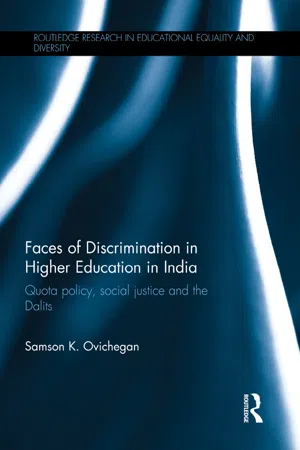
Faces of Discrimination in Higher Education in India
Quota policy, social justice and the Dalits
- 204 pages
- English
- ePUB (mobile friendly)
- Available on iOS & Android
Faces of Discrimination in Higher Education in India
Quota policy, social justice and the Dalits
About This Book
This book illuminates the experiences of a set of students and faculty who are members of the Dalit caste – commonly known as the 'untouchables' – and are relatively 'successful' in that they attend or are academics at a prestigious university. The book provides a background to the study, exploring the role of caste and its enduring influence on social relations in all aspects of life. The book also contains a critical account of the current experiences of Dalit students and faculty in one elite university setting – the University of Shah Jahan (pseudonym). Drawing on a set of in-depth semi-structured interviews, the empirical study that is at the centre of this book explores the perceptions of staff and students in relation to the Quota policy and their experiences of living, working and studying in this elite setting. The data chapters are organised in such a way as to first explore the faculty views. The experiences of students are then examined with a focus on the way in which their caste is still an everyday part of how they are sometimes 'othered'. Also, a focus on female Dalit experiences attempts to capture the interconnecting aspects of abject discrimination in their university life. Faces of Discrimination in Higher Education in India explores:
-
- critical exploration of the Quota System policy and related social justice issues;
-
- faculty voices: Quota, caste and discrimination;
-
- students' perceptions and experiences of the Quota policy;
-
- being a 'female Dalit' student;
-
- positioning caste relations and the Quota policy: a critical analysis.
This study will be of interest to educational sociologists examining policies in education and analysts of multicultural and South Asian studies. It will also steer pertinent discussions on equality and human rights issues.
Frequently asked questions
Information
1 Introduction
The caste situation
Caste: historical perspective
The Dalit (‘Untouchables’)
The ‘Dalit’ caste
Origins of the ‘Dalit’ caste
it is better that one should live by doing the vile works allotted to his caste than embrace the vocation of a superior caste for livelihood – living by adopting the vocation of another caste, one becomes degraded that very day.(p. 58)
Exclusion and discrimination: ‘race/class and caste’
Table of contents
- Cover Page
- Half Title Page
- Title Page
- Copyright Page
- Dedication
- Table of Contents
- Acknowledgements
- List of abbreviations
- Abstract
- Brief overview of book chapters
- 1 Introduction
- 2 Critical exploration of the Quota System policy and related social justice issues
- 3 Faculty voices: Quota, caste and discrimination
- 4 Students’ perceptions and experiences of the Quota policy
- 5 Being a ‘female Dalit’ student
- 6 Positioning caste relations and the Quota policy: a critical analysis
- 7 Conclusion
- Bibliography
- Index